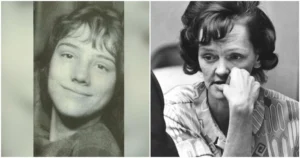Gertrude Baniszewski‘s name is indelibly linked with one of the most heinous crimes in American history. Known infamously as the mastermind behind the brutal torture and murder of Sylvia Likens, Baniszewski’s story is a grim reminder of the depths of human cruelty. This article delves into the life of Gertrude Baniszewski, the horrifying crime she orchestrated, and its subsequent impact on American society and the justice system.

Early Life of Gertrude Baniszewski
Gertrude Nadine Baniszewski, who was born Gertrude Nadine Van Fossan on September 19, 1929, in Indianapolis, Indiana, experienced a life of instability and hardship. Raised in a tumultuous household, Baniszewski experienced a troubled childhood that set the stage for her later actions. After several failed marriages and financial difficulties, Baniszewski found herself struggling to provide for her seven children. Her increasing mental instability and a lack of social support marked her descent into criminality.
The Arrival of Sylvia Likens
In the summer of 1965, Sylvia Likens and her sister, Jenny, were left in the care of Gertrude Baniszewski while their parents traveled for work. The arrangement was supposed to be temporary, but it soon turned into a nightmare for the Likens sisters. Sylvia, a vibrant and healthy 16-year-old girl, became the target of Baniszewski’s growing frustrations and sadistic tendencies.
Gertrude Baniszewski The Torture and Murder of Sylvia Likens
The abuse began with small punishments but quickly escalated into severe and prolonged torture. Baniszewski, along with her children and some neighborhood kids, subjected Sylvia to unimaginable suffering. The torture included beatings, burning, starvation, and verbal humiliation. Over the course of three months, Sylvia endured relentless physical and emotional abuse, leading to her death on October 26, 1965.
Detailed Accounts of the Abuse
Sylvia’s ordeal was marked by acts of extreme brutality. She was often tied up, deprived of food and water, and forced to eat her own feces. Baniszewski used heated needles to carve words into Sylvia’s abdomen, leaving permanent scars. The neighborhood children, encouraged by Baniszewski, participated in the abuse, demonstrating the chilling influence she had over them.
Gertrude Baniszewski The Investigation and Trial
Sylvia Likens’ death was initially reported as a runaway case, but the truth soon emerged, revealing a story of horrifying abuse. The police investigation uncovered the full extent of Sylvia’s suffering, leading to the arrest of Gertrude Baniszewski, her children, and several neighborhood participants.
Court Proceedings
The trial of Gertrude Baniszewski and her co-defendants attracted significant media attention. Baniszewski was portrayed as a manipulative and sadistic figure, orchestrating the abuse while coercing others to participate. The defense attempted to paint Baniszewski as mentally unstable, but the overwhelming evidence of her actions led to a guilty verdict.
Gertrude Baniszewski Conviction and Sentencing
In 1966, Gertrude Baniszewski was convicted of first-degree murder and sentenced to life in prison. Her children and the other participants received various sentences for their roles in the crime. Baniszewski’s trial highlighted the need for better protection for vulnerable children and led to significant changes in child welfare laws.
Gertrude Baniszewski Aftermath and Legacy
Gertrude Baniszewski’s story did not end with her conviction. She was paroled in 1985, after serving 19 years in prison, sparking public outrage. Baniszewski lived the remainder of her life under an assumed name, dying in 1990. The case of Sylvia Likens left an indelible mark on American society, influencing legal reforms and serving as a cautionary tale about the potential for human cruelty.
Impact on Child Welfare Laws
The Likens case prompted a nationwide examination of child protection laws. It underscored the importance of vigilant oversight and intervention by authorities in cases of suspected child abuse. The reforms that followed aimed to prevent similar tragedies and ensure that children in vulnerable situations received the necessary protection and support.
Gertrude Baniszewski Cultural and Media Influence
The horrific story of Sylvia Likens has been the subject of numerous books, films, and documentaries, each exploring the depths of the abuse she suffered and the psychological profile of her abuser. These works serve to educate the public about the realities of child abuse and the importance of community vigilance.
Conclusion
The story of Gertrude Baniszewski and the tragic fate of Sylvia Likens is a dark chapter in American crime history. It highlights the importance of child protection, the consequences of unchecked cruelty, and the need for societal awareness and intervention in cases of abuse. As we reflect on this harrowing tale, it is crucial to remember the lessons learned and to continue advocating for the safety and well-being of all children.



